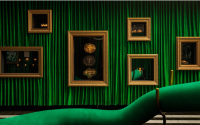Richard Pettibone, Artist Who Appropriated Others’ Paintings for His Own Work, Dies at 86
Richard Pettibone, a painter whose enigmatic work involved copying famed contemporary artworks and then exhibiting these smaller-scale lookalikes, died on August 19 at 86. A representative for New York’s Castelli Gallery, which has shown Pettibone since 1969, said he died following a fall.
During the 1960s, well before the heyday of appropriation art two decades later, Pettibone began making replicas of paintings by Andy Warhol, Roy Lichtenstein, Frank Stella, and others. Unlike Sturtevant, another artist famous for duplicating well-known pieces by giants of contemporary art, Pettibone produced objects that were clearly different in size from the originals.
Many of Pettibone’s paintings were far smaller than their source materials. This choice was part of Pettibone’s conceptual game of determining what constitutes value. Notably, he began this project during the ’60s, at a time when the art market was greatly expanding.
The work was only partially intended as parody. “Stella thinks I’m mocking him, and he’s right, I am mocking him,” Pettibone once told Art in America. “But I also greatly admire him. But I have to wonder, if he really thinks that a work of art has no meaning, that it’s just paint on a canvas, then how come his is so much more valuable than mine?”
Later on, Pettibone went on to also copy sculptures, exactingly producing miniature versions of Warhol’s Brillo boxes and Duchamp’s readymades. Duchamp, critic Ken Johnson once noted, “was modern art’s great sorcerer, Mr. Pettibone one of his craftiest apprentices.”
Pettibone was born in 1938 in Los Angeles and went on to attend the Otis Art Institute. His first major exhibition was staged in 1964 at the trendsetting Ferus Gallery, where, two years earlier, Warhol had shown his Campbell’s soup can paintings, riling up critics and artists alike. “Many, many of the other artists who saw it really hated it,” Pettibone told A.i.A. “They were pounding the tables with anger, screaming, ‘This is not art!’ I told them, this may be the worst art you’ve ever seen, but it’s art. It’s not sports!”
The Warhol show was formative to Pettibone, who went on to make his own Campbell’s soup can paintings. These were so loyal to Warhol’s work that they even contained the Pop artist’s name rubber-stamped onto them. The only difference was that Pettibone’s name was stamped alongside it.
When not imitating recent masterworks, Pettibone was obsessing over the poet Ezra Pound, whose book covers he loyally copied for one series made in the ’90s. Pettibone also made Photorealist paintings during the ’70s.
Although not exactly under-recognized in New York, the city where he was based for part of his career, Pettibone is perhaps not quite as well known as artists such as Sherrie Levine and Louise Lawler, two Pictures Generation artists known for featuring images of famed artworks in their photography. But Pettibone did receive his due institutionally in the form of a 2005 retrospective that originated at Philadelphia’s Institute of Contemporary Art.
“Mr. Pettibone is a connoisseur and careful explorer of the chief wellspring of art-making: the simple love of art,” Roberta Smith wrote in her New York Times review of that exhibition. “His work makes transparent the complex mixture of discernment, admiration and competition that spurs artists to make something they can call their own.”


